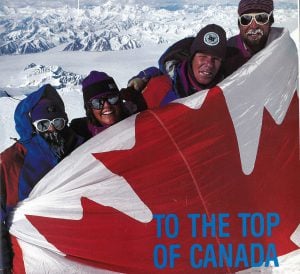Tent life on Mt. Steele. We were frequently held down by violent multi-day wind storms. (Photo: Lonnie Dupre)
But that night, when we got into our sleeping bags, we both knew that the expedition was over. Early on we had noticed our sleeping bags beginning to ice up, but the last 36 hours of being tent-bound in the storm had dramatically increased the moisture in our bags. They were now a solid block of ice when coming out of the stuff sack. After prying them apart, we had to lay in our beds of icy, clumped-together down feathers and melt them with our body heat over the next two hours. Now lying in damp bags, it was virtually impossible to stay warm.
We knew the icing would continue to worsen, that we had high-effort days ahead, that we would be chilled from the increase in altitude, and that two gale force wind storms were on the horizon, along with a plunge in temperatures. Continuing in these conditions with no way to sleep or stay warm at night was flirting with disaster. Sometimes the decision to turn around is tough to make, but our choice was clear. There was no way we could safely proceed given the iced-up condition of our sleep systems.
I was less sad than might be expected, mainly because we were content with what we had accomplished and learned, and we feel better prepared for a stronger attempt next time. We now know that we have a solid approach route, one that will allow us to pull our supplies up to a closer basecamp and tackle the mountain in a fresher physical and mental state.
Retracing our steps after the storm was fascinating; scoured by the relentless wind, our footsteps had formed incredibly beautiful sastrugi. We still had a nagging concern about our pick-up, however. Given our high-altitude landing, we were worried about taking off fully loaded. Getting to a lower altitude was not possible due to a large icefall below the glacier. We understood that we might need three flights out, or perhaps a helicopter. The sastrugi, too, although lovely, were an issue. The soft, deep powder had been replaced by an ocean of hard packed snow waves.
Lonnie spent a couple of hours searching the glacier for a “flat” area, just long enough for the plane to land and take off. We found one, then got to work shovelling and stomping down some of the larger humps before informing John that the makeshift runway was flagged, safe and ready for landing.
When one tackles such “firsts,” one knows that there will be a steep learning curve. Terrain, route, weather patterns and even the logistics of getting to and from the mountain are to a large extent unknown and unpredictable variables. The beauty of exploration is that we build contacts and develop knowledge together, as a united team: Parks Canada, Rocking Star Adventures and ourselves.
So, goodbye for now, gorgeous alpenglow sunrises, pink-and-blue skies, endless vistas of icy peaks, raging winds. You are full of character, dear St. Elias mountain range, and we will be back next winter to take in all that magic once again.








